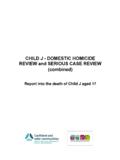Transcription of BRIEF SUMMARY OF THE SERIOUS CASE REVIEW
1 BRIEF SUMMARY OF THE SERIOUS case REVIEW This REVIEW is about the sexual exploitation of children in oxfordshire . It uses as background the experiences of six girls who were the victims in the Operation Bullfinch trial. When most of the abuse took place there was almost no knowledge of group or gang related Child sexual exploitation anywhere in the country. While it is easy looking back to say it was obvious , at the time it was something organisations did not understand. The REVIEW says many errors were made, and shows what lay behind them. Organisations had a weak understanding of government guidance related to the exploitation of children.
2 This was the case all over the country, not just locally. This lack of understanding meant that police and social workers did not look hard enough at what was happening to the girls. The girls were not able to make their own decisions because of the grooming, but staff tended to see them as difficult girls making bad choices. This mistaken conclusion meant that staff did not look enough at what was drawing them away from their homes (their own homes or care placements). There was not enough investigation. The language used by professionals described the girls behaviour as caused by them, not their situation with the groomers.
3 As a result, the girls received much less sympathy than they should have received. They were often in care for their own protection, but their frequent episodes of going missing were seen to be because they were difficult children. The law around consent was not properly understood. There was confusion around the fact that young teenagers can consent to use contraception to have sex that might be illegal. This makes it easier for the exploiters. Young teenagers were seen too much as young adults rather than as children. Some professionals seemed to get used to knowing the girls were having sex with men, rather than having a clear view that it was wrong, full stop.
4 The victims almost never cooperated with investigations. This was caused by the grooming and fear. There was a sense that nothing could be done as evidence was weak. The need for disruption, investigation and careful information-gathering, even when there is no formal evidence from victims, was not understood as it is now. The lack of cooperation and behaviour of the victims sometimes led to crimes against them not being recorded as crimes, when clearly they were. This was wrong. There was a lack of curiosity across agencies about the visible suffering of the children and information given by girls, parents, carers, and worried staff.
5 Also, there was a failure to recognise that the situation was so bad it should be reported to top managers, so they could start a county-wide response. Instead, the cases were seen more in isolation, with the focus mainly on protecting and containing the girls, rather than tackling the perpetrators. There was no evidence that the race and ethnic background of the exploiters stopped the professionals from identifying the child sexual exploitation earlier. The REVIEW shows that from 2005-10 there was enough known about the girls, drugs, sexual exploitation , and association with adult men to start a more SERIOUS response.
6 But this did not happen and mostly the information did not reach high levels. As well as the errors seen in other places, there were reasons why in oxfordshire the group abuse was not recognised earlier, when there were opportunities to do so. The oxfordshire Safeguarding Children Board, and the committee which was there before it, did not show sufficient grip or curiosity when some early signs were presented, and child sexual exploitation drifted off the agenda. Children s Social Care was at the time of much of the abuse regarded as only adequate by Ofsted. Another REVIEW showed the oxfordshire Safeguarding Children Board needed to improve.
7 Social worker numbers were at one point amongst the lowest in the country, leading to high caseloads, and supervision of staff was not strong. Child protection processes were not always strong. These extremely worrying cases were not reported to top bosses. The Police, at that time, did not have good systems for seeing patterns across the force so did not piece together the different cases. There are signs that top level commitment from the different organisations to the oxfordshire Safeguarding Children Board varied, and that the Board did not follow things through properly. Really important national guidance on child sexual exploitation published in 2009 was overlooked.
8 As a result, the Child sexual exploitation that later emerged in the Bullfinch inquiry and trial was led, not by top managers and committees, but by more junior staff working nearer the families. A drugs worker for the City Council, a social worker, and a detective inspector, on their own initiative, each led a number of meetings which were unknown to the oxfordshire Safeguarding Children Board or top managers. Their efforts discovered there was group exploitation of multiple girls. Action from this point became coordinated and successful leading to many convictions. Since this turning point in early 2011, oxfordshire has responded very well indeed to the challenge, is rated as good , and is held up as a good example of how Child sexual exploitation should be tackled.
9 There is no denial by local organisations of either the errors made, or the scale of abuse, and top level apologies have been made to the victims and their families. The REVIEW identifies around 60 learning points that will help agencies understand why and what needs to happen to be sure Child sexual exploitation continues to be tackled well.









